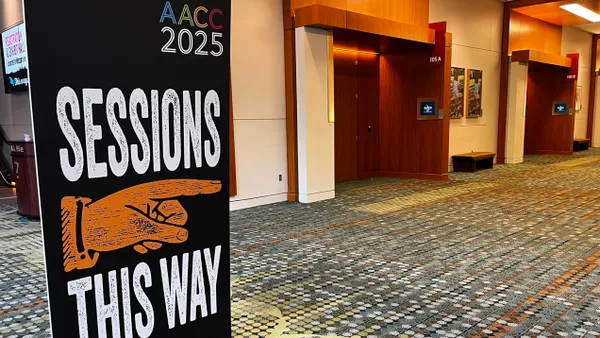Dive Brief:
- A program to examine and improve outcomes for students transferring between City University of New York colleges helped increase the number of students who were able to use all transfer credits toward their degrees, according to a consulting group involved in the project.
- In fall 2019, only 58% of students transferring from Hostos Community College to Lehman College were able to use all of their transfer credits towards their degrees. With process improvements and advising through the program, that rose to 72% of students in fall 2021, according to a report. In another instance, academic intervention allowed students to qualify for additional financial aid benefits.
- Project leaders believe other colleges and universities could benefit from the program, known as the Articulation of Credit Transfer project. But implementation would vary, said Martin Kurzweil, director of the educational transformation program at Ithaka S+R, a nonprofit group coordinating the project.
Dive Insight:
Nationally, 43% of credits are lost when students transfer between colleges because the institutions they're entering don't accept them, according to one study from the U.S. Government Accountability Office. To help ensure CUNY students can use the credits they earned, the ACT project started by creating a daily data archive covering students transferring between the system's participating institutions. That enabled analysis of whether transferred courses counted toward students' degrees.
ACT is partnered with seven CUNY campuses — Lehman College, Bronx Community College, Hostos Community College, Brooklyn College, Guttman Community College, Queens College and Queensborough Community College. The project identified all students who are direct transfers from participating community colleges to four-year degree programs. ACT's data excludes the community college students who already earned a bachelor's degree and students in nondegree programs.
The project received roughly $1.1 million in grant funding, covering operations from January 2019 through June 2022. Archiving for students transferring from Hostos to Lehman began in September 2019. The project began including students transferring from Bronx Community College to Lehman the following fall. All other participating campuses joined archiving in January 2021.
Researchers were able to inform curricular decisions by identifying the courses students took that regularly didn't transfer. One example is Hostos' anatomy and physiology II course. A large number of students who took the course only to have it fall through were nursing majors, for whom it was required. But when they transferred to Lehman, many of these students did not pursue a nursing major. The anatomy and physiology course may not satisfy other major or general education requirements.
The example highlights a need for efficient off-ramps for students who plan to enroll in bachelor of science in nursing programs but ultimately do not do so, according to Ithaka S+R's report. It also pointed to a need for more seats in the nursing programs, which are highly competitive and may not accept transferring students.
Academic intervention also led to students receiving financial aid benefits through New York's Tuition Assistance Program, which requires students to take 12 credits per semester toward their degree requirements.
"It helped them qualify for funding they would have missed otherwise," said Kurzweil, who is a co-author of the report on the project. "Over a dozen students actually got TAP funding because an adviser realized they were short on credits."
If any current-term courses don't apply to their degrees after they transfer, students could lose TAP eligibility. An auditor at Lehman reached out to 19 students in a fall 2021 cohort who were just under the credit threshold because of registration changes. The auditor helped them make registration changes to qualify for TAP funding, and the students received an average award of almost $1,500 each.
ACT also created Transfer Explorer, an online tool that allows the public to see how courses will transfer between CUNY institutions.
Kurzweil said he is optimistic the ACT project can help other colleges, but the process would need to be customized to each institution's needs.
"There's a lot to be gained, but it's not a one-size-fits-all solution," he said. "Not all schools and school systems are as interconnected as CUNY."
Every campus in CUNY uses the same degree audit software. The ACT program found that the software overwrote each student’s degree audit data every time there was a change to their record. Finding a fix meant potentially increasing the amount of transfer data available to every CUNY college in the process.
Ithaka S+R's report on the project highlights the importance of data collection and process improvement. Kurzweil said humans will still have a major role to play.
"We’ll be able to automate more components of the process as we learn more," Kurzweil said. "But advising from human beings is always going to be an important part of the equation."














